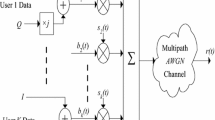Abstract
In this paper, we exploit transmit diversity in downlink multicarrier CDMA (MC-CDMA) system to provide a solution to a high data rate, high capacity, yet reliable and robust to fading channel network. Our first emphasis is on designing a blind (without knowing the undesired users' signatures and channel parameters) MC-CDMA receiver in the mobile station that can suppress the multiple access interference (MAI) and combine the desired signal stemmed from all the transmitting antennas. Two blind signal reception algorithms are proposed and the performances in terms of signal-to-interference-and-noise-ratio (SINR) are comprehensively analyzed. One is based on the decorrelating RAKE (DRAKE) scheme proposed in [IEEE Trans. Communs. 47(7), 1036–1045, 1999] and the other is designed to meet the minimum output energy (MOE) criterion [IEEE Trans. on Information Theory 41(4), 944–996, 1995]. The MOE receiver, though optimum in ideal situation, is semi-blind that the vector channel impulse responses (VCIR) should be explicitly known. While the proposed modified DRAKE receiver is completely blind that it does not require any information of VCIR. Furthermore, we demonstrate that in practical scenario, the modified DRAKE scheme substantially outperforms the MOE receiver. The second part of this paper is to develop an efficient and blind (without requiring training sequences) algorithm to estimate the VCIR of downlink antenna array MC-CDMA system. Simulation results show that both the channel estimation algorithm and the blind reception schemes are reliable and near-far resistant.
Similar content being viewed by others
References
V.K. Grag, IS-95 CDMA and cdma2000, Upper Saddle River, NJ: Prentice Hall, 2000.
T.S. Rappaport, Wireless Communications: Principles and Practice, Upper Saddle River, NJ: Prentice Hall, 1996.
R. Price, Jr. and P.E. Green, “A Communication Technique for Multipath Channels”, Proc. IRE, 46: pp. 555–570, March 1958.
J. Proakis, Digital Communications, New York: McGraw-Hill, 1989.
A.F. Naguib, “Space-Time Receivers for CDMA Multipath Signals”, IEEE SP Letters, pp. 304–308, 1997.
H. Khalaj, A.J. Paulraj, and T. Kailath, “2-D RAKE Receiver for CDMA Cellular System”, IEEE Globecom’94, pp. 400–404, 1994.
S. Verdu, Multiuser Detection, Cambridge University Press, 1998.
R. Prasad, OFDM for Wireless Multimedia Communications, Artech House Publishers, 2000.
N. Yee, J-P. Linnartz and G. Fettweis, “Multicarrier CDMA in Indoor Wireless Radio Networks”, Proceedings of the IEEE PIMRC’93, Yokohama, Japan, Sept. 1993, pp. 109–113.
S. Kondo and L.B. Milstein, “Performance of Multicarrier DS-CDMA Systems”, IEEE Trans. Communications, Vol. 44, No. 2, pp. 238–246, February 1996.
V.M. DaSilva and E.S. Sousa, “Performance of Orthogonal CDMA Codes for Quasi-Synchronous Communication Systems”, Proc. of IEEE ICUPC’93, Ottawa, Canada, October 1993, pp. 995–999.
L. Vandendorpe, “Multitone Direct Sequence CDMA System in an Indoor Wireless Environment”, Proceedings of IEEE First Symposium of Communications and Vehicular Technology, October 1993, pp. 4.1.1–4.1.8.
S. Hara and R. Prasad, “Overview of Multicarrier CDMA”, IEEE Commun. Magazine, Vol. 35, No. 12, pp. 126–133, December 1997.
H. Bogucka, “Transmission and Reception of the Multicarrier CDMA Signals in the 3rd Generation Mobile Communication System”, ICPWC’96, pp. 319–322.
H. Liu, Signal Processing Applications in CDMA Communications, Chapter 5, Artech House Publishers, 2000.
S. Hara and R. Prasad, “Design and Performance of Multicarrier CDMA System in Frequency-Selective Rayleigh Fading Channels”, IEEE Trans. Veh. Technol., Vol. 48, pp. 1584–1594, September 1999.
H.Liu and H. Yin, “Receiver Design in Multicarrier Direct-Sequence CDMA Communications”, IEEE Trans. On Communications, Vol. 49, No. 8, pp. 1479–1487, August 2001.
X. Cai and A.N. Akansu, “Multicarrier CDMA Systems With Transmit Diversity”, VTC 2000, pp. 2817–2821.
H.L. Van Tree, Optimum Array Processing, John Wiley & Sons, Inc., 2002.
M.L. Honig, U. Madhow and S. Verdu, “Blind Adaptive Multiuser Detection”, IEEE Trans. on Information Theory, Vol. 41, No. 4, pp. 944–996, July 1995.
H. Liu and K. Li, “A Decorrelating RAKE Receiver for CDMA Communications Over Frequency-Selective Fading Channels”, IEEE Trans. Communs., Vol. 47, No. 7, pp. 1036–1045, July 1999.
R.O. Schmidt, “Multiple Emitter Location and Signal Parameter Estimation”, IEEE Trans. Ant. Propagation, Vol. AP-34, pp. 276–290, March 1986.
H. Liu and G. Xu, “A Subspace Method for Signature Waveform Estimation in Synchronous CDMA Systems”, IEEE Trans. Commun., Vol. COM-44, No. 10, pp. 1346–1354, October 1996.
Author information
Authors and Affiliations
Corresponding author
Additional information
Wei-Chiang Wu received the M.S. and Ph.D. degrees both in electrical engineering from the National Tsing Hua University, Hsin-chu, Taiwan, R.O.C., in 1992 and 1998, respectively. From 1992 to 1994, he was an assistant researcher in the Communication Department at Chung Shan Institute of Science and Technology (CSIST), Taiwan, R.O.C.. From 1998 to 2000, hewas in the Army of Taiwan, where he conducted the research of Integrated Logistic Support (ILS). Since 2000, he has been an assistant Professor at the Department of Electrical Engineering, Da Yeh University, Changhua, Taiwan. His current research interests are in multiuser detection, smart antenna technology, multi-carrier CDMA and ultra-wideband (UWB) impulse radio (IR) technology.
Rights and permissions
About this article
Cite this article
Wu, WC. Blind Signal Reception and Channel Estimation in Downlink MC-CDMA Communication System with Transmit Diversity. Wireless Pers Commun 39, 467–486 (2006). https://doi.org/10.1007/s11277-006-9092-z
Published:
Issue Date:
DOI: https://doi.org/10.1007/s11277-006-9092-z




